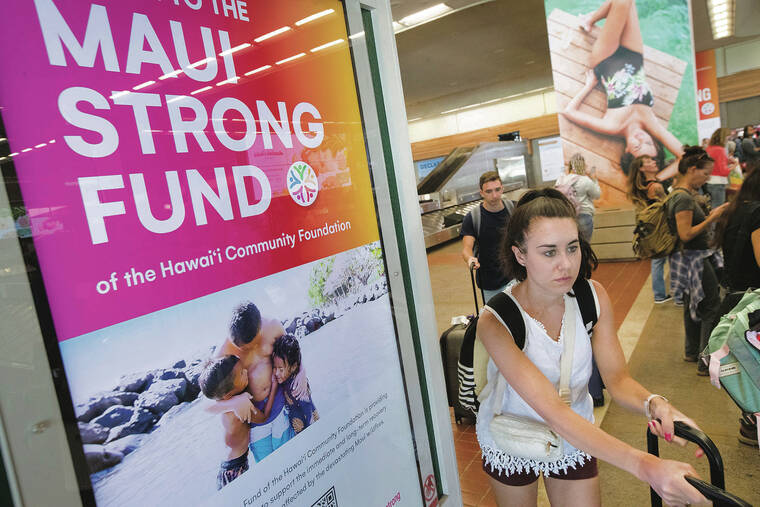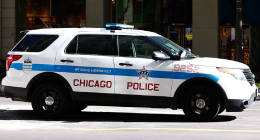
Mahalo for supporting Honolulu Star-Advertiser. Enjoy this free story!
People both supporting and criticizing Sunday’s official planned reopening of tourism to West Maui should not expect an “onslaught” of visitors.
“The sentiment is that we’ll have this onslaught of visitors, and that’s not just going to happen,” said Lisa Paulson, executive director of the Maui Lodging and Hotel Association.
On the eve of the reopening, which was announced Sept. 8 by Gov. Josh Green, visitor occupancy in West Maui hotels was forecast to tick up to 4.4% today from 4.1% on Thursday, according to a survey Paulson conducted.
Visitor occupancy in West Maui should then more than double to 9.3% on Sunday when tourists have been encouraged to visit and support local businesses. The date marks two months since the deadly Aug. 8 wildfire that killed at least 98 people and all but obliterated Lahaina.
Visitor occupancy should then steadily increase next week to 16.8% on Oct. 14, for an average of about 12% next week.
Paulson’s survey through Nov. 18 expects that visitor occupancy will mostly increase steadily, peaking at 34.5% on Nov. 11, then falling to 33.7% on Nov. 18.
The forecast spans the rest of Hawaii’s typically slow “shoulder season” before the winter holidays.
In a filing to the Securities and Exchange Commission, Hawaiian Airlines said it expected revenue per air miles to fall 4% to 7% for the third quarter of the year “primarily due to reduced travel demand following the Maui wildfires” in Lahaina and the Upcountry region.
Air visitor arrivals to Maui had increased 5.5% for the first half of 2023, compared with the first half of 2022 — 1.51 million compared to 1.43 million, said Eugene Tian, chief economist for the state Department of Business, Economic Development and Tourism.
But the number of Maui visitors arriving by air is forecast to plummet 35.9% in the second half of 2023, compared with the same period in 2022 — 985,703 versus 1.54 million, Tian said.
Hawaiian currently flies an average of 32 daily neighbor island round trips and 10 trans-Pacific flights to and from Kahului. The company will monitor its Maui flights and adjust capacity as necessary, spokesperson Alex Da Silva said.
For Maui hotels the low visitor occupancy has been offset by the influx of hundreds of wildfire relief workers from around the county and fire evacuees who have been set up with temporary shelter in West Maui hotels.
“With leisure and government workers and displaced residents, we’re looking at 60% to 75% occupancy,” Paulson said.
Some 7,800 fire evacuees are staying in over 3,000 hotel rooms, she said.
While the demographics are different, West Maui hotel occupancy since the Aug. 8 fire tracks with Maui County’s overall 65.1% hotel occupancy in 2022 and 68.7% specifically for Lahaina, Kaanapali and Kapalua in 2022, Tian said.
For 2023, hotel occupancy likely will be unpredictable in the days and months ahead with more visitors expected to arrive — at the urging of Green, Maui County Mayor Richard Bissen and business interests — while the Maui Lodging and Hotel Association works with DBEDT to find more comfortable longer-term housing in Airbnbs, Vrbos and other short-term rentals for survivors, Paulson said.
And it’s unknown when future waves of post-fire recovery workers will arrive on Maui, such as additional cleanup crews, construction workers and contractors.
“We’re literally just taking this one day at a time,” Paulson said. “Our focus is on displaced residents and finding them vacation rentals with yards and laundry and the ability to park your car.”
People staying in West Maui hotels had been given a deadline to document that they were displaced by the fires, leading to widespread fears and rumors that legitimate evacuees were going to be evicted. But Paulson said anyone who can prove they were living in the disaster zones will be allowed to stay in Maui hotels until they can be placed in longer-term housing.
“Once they’re verified, there is no end date,” Paulson said. “They are not going to kick anybody out. Nobody would do that.”
The American Red Cross said more than 2,200 households had verified their eligibility as of Sept. 29.
“Survivors who had not yet confirmed eligibility were notified to register with the American Red Cross to determine their next steps,” the Red Cross said.
Bissen announced a staggered reopening of West Maui tourism with the first phase covering the area from the Ritz-Carlton Maui, Kapalua, to Kahana Villa, which is not enjoying the same level of room occupancy, Paulson said.
“From the Ritz-Carlton to the northernmost part of West Maui does not have as many displaced residents, that many guests, and I don’t believe they’re getting many federal workers,” she said.
There are no dates yet for the next two phases of reopening tourism in West Maui. They’ll be set after each previous phase has been assessed, Bissen’s office announced.
The second area to be reopened has been planned for Mahinahina to Maui Kaanapali Villas, followed by the third phase from the Royal Lahaina Resort to the Hyatt Regency Maui Resort &Spa in Kaanapali.
In the meantime, hotels continue to struggle in South Maui and Hana, where the beaches are empty, Paulson said.
While only the Lahaina burn zone remains off limits, other Maui hotels “have been affected by the overall confusing message that’s out there,” Paulson said.
But in his announcement of Sunday’s opening of West Maui to tourism, Bissen said: “The only locations on Maui that have been completely closed have been historic Lahaina town and the surrounding areas impacted by the fire of August 8.
“However, while the rest of West Maui remained open with small businesses operating and hotel properties utilized for disaster victims, visitors were encouraged to visit other locations on Maui out of respect for the great sensitivity to the area and the gravity of the situation for affected residents.”
Overall, Paulson said, “air arrivals are down and our beaches are empty.”
Maui’s “direct, indirect, and induced impacts” from tourism stood at 38% in 2017, then plummeted to 13.6% with the advent of COVID-19 in 2020.
It took two more years for Maui visitor arrivals to reach 95.4% of their 2019 pre-COVID-19 level, Tian said. After the wildfires, visitor arrivals plummeted to 43% of their August 2019 level, he said.
It will take more than two years for visitor arrivals to rebound to where they were before the fires.
“DBEDT expects visitor arrivals will continue to be lower than 2022 level until the first half of 2024,” Tian said, “and then will recover faster after, but full recovery will be in 2026.”
Read More: World News | Entertainment News | Celeb News
Star









